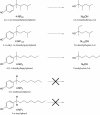Differential degradation of nonylphenol isomers by Sphingomonas xenophaga Bayram
- PMID: 15746308
- PMCID: PMC1065174
- DOI: 10.1128/AEM.71.3.1123-1129.2005
Differential degradation of nonylphenol isomers by Sphingomonas xenophaga Bayram
Abstract
Sphingomonas xenophaga Bayram, isolated from the activated sludge of a municipal wastewater treatment plant, was able to utilize 4-(1-ethyl-1,4-dimethylpentyl)phenol, one of the main isomers of technical nonylphenol mixtures, as a sole carbon and energy source. The isolate degraded 1 mg of 4-(1-ethyl-1,4-dimethylpentyl)phenol/ml in minimal medium within 1 week. Growth experiments with five nonylphenol isomers showed that the three isomers with quaternary benzylic carbon atoms [(1,1,2,4-tetramethylpentyl)phenol, 4-(1-ethyl-1,4-dimethylpentyl)phenol, and 4-(1,1-dimethylheptyl)phenol] served as growth substrates, whereas the isomers containing one or two hydrogen atoms in the benzylic position [4-(1-methyloctyl)phenol and 4-n-nonylphenol] did not. However, when the isomers were incubated as a mixture, all were degraded to a certain degree. Differential degradation was clearly evident, as isomers with more highly branched alkyl side chains were degraded much faster than the others. Furthermore, the C9 alcohols 2,3,5-trimethylhexan-2-ol, 3,6-dimethylheptan-3-ol, and 2-methyloctan-2-ol, derived from the three nonylphenol isomers with quaternary benzylic carbon atoms, were detected in the culture fluid by gas chromatography-mass spectrometry, but no analogous metabolites could be found originating from 4-(1-methyloctyl)phenol and 4-n-nonylphenol. We propose that 4-(1-methyloctyl)phenol and 4-n-nonylphenol were cometabolically transformed in the growth experiments with the mixture but that, unlike the other isomers, they did not participate in the reactions leading to the detachment of the alkyl moiety. This hypothesis was corroborated by the observed accumulation in the culture fluid of an as yet unidentified metabolite derived from 4-(1-methyloctyl)phenol.
Figures



Similar articles
-
A novel metabolic pathway for degradation of 4-nonylphenol environmental contaminants by Sphingomonas xenophaga Bayram: ipso-hydroxylation and intramolecular rearrangement.J Biol Chem. 2005 Apr 22;280(16):15526-33. doi: 10.1074/jbc.M413446200. Epub 2005 Jan 21. J Biol Chem. 2005. PMID: 15665329
-
Microbial degradation of a single branched isomer of nonylphenol by Sphingomonas TTNP3.Water Sci Technol. 2004;50(5):189-94. Water Sci Technol. 2004. PMID: 15497847
-
The degradation of alpha-quaternary nonylphenol isomers by Sphingomonas sp. strain TTNP3 involves a type II ipso-substitution mechanism.Appl Microbiol Biotechnol. 2006 Mar;70(1):114-22. doi: 10.1007/s00253-005-0080-0. Epub 2005 Aug 10. Appl Microbiol Biotechnol. 2006. PMID: 16091931
-
Microbial degradation of nonylphenol and other alkylphenols--our evolving view.Appl Microbiol Biotechnol. 2006 Sep;72(2):223-43. doi: 10.1007/s00253-006-0476-5. Epub 2006 Jul 7. Appl Microbiol Biotechnol. 2006. PMID: 16826376 Review.
-
The degradation of alkylphenols by Sphingomonas sp. strain TTNP3 - a review on seven years of research.N Biotechnol. 2012 Nov 15;30(1):88-95. doi: 10.1016/j.nbt.2012.07.008. Epub 2012 Jul 27. N Biotechnol. 2012. PMID: 22842087 Review.
Cited by
-
Identification of opdA, a gene involved in biodegradation of the endocrine disrupter octylphenol.Appl Environ Microbiol. 2007 Nov;73(22):7373-9. doi: 10.1128/AEM.01478-07. Epub 2007 Sep 21. Appl Environ Microbiol. 2007. PMID: 17890335 Free PMC article.
-
Isolation and characterization of 4-tert-butylphenol-utilizing Sphingobium fuliginis strains from Phragmites australis rhizosphere sediment.Appl Environ Microbiol. 2010 Oct;76(20):6733-40. doi: 10.1128/AEM.00258-10. Epub 2010 Aug 27. Appl Environ Microbiol. 2010. PMID: 20802076 Free PMC article.
-
Degradation Potential of the Nonylphenol Monooxygenase of Sphingomonas sp. NP5 for Bisphenols and Their Structural Analogs.Microorganisms. 2020 Feb 19;8(2):284. doi: 10.3390/microorganisms8020284. Microorganisms. 2020. PMID: 32093107 Free PMC article.
-
Effect of rice-straw biochar on selective biodegradation of nonylphenols in isomer specificity.Environ Sci Pollut Res Int. 2017 Sep;24(25):20567-20576. doi: 10.1007/s11356-017-9375-9. Epub 2017 Jul 15. Environ Sci Pollut Res Int. 2017. PMID: 28710737 Free PMC article.
-
Bacterial degradation of tert-amyl alcohol proceeds via hemiterpene 2-methyl-3-buten-2-ol by employing the tertiary alcohol desaturase function of the Rieske nonheme mononuclear iron oxygenase MdpJ.J Bacteriol. 2012 Mar;194(5):972-81. doi: 10.1128/JB.06384-11. Epub 2011 Dec 22. J Bacteriol. 2012. PMID: 22194447 Free PMC article.
References
-
- Ahel, M., W. Giger, and M. Koch. 1994. Behavior of alkylphenol polyethoxylate surfactants in the aquatic environment. I. Occurrence and transformation in sewage treatment. Water Res. 28:1131-1142.
-
- Brunner, P. H., S. Capri, A. Marcomini, and W. Giger. 1988. Occurrence and behaviour of linear alkylbenzenesulphonates, nonylphenol, nonylphenol mono- and nonylphenol diethoxylates in sewage and sewage sludge treatment. Water Res. 22:1465-1472.
-
- Corvini, P. F. X., R. Vinken, G. Hommes, B. Schmidt, and M. Dohmann. 2004. Degradation of the radioactive and non-labelled branched 4(3′,5′-dimethyl-3′-heptyl)-phenol nonylphenol isomer by Sphingomonas TTNP3. Biodegradation 15:9-18. - PubMed
-
- Dachs, J., D. A. Van Ry, and S. J. Eisenreich. 1999. Occurrence of estrogenic nonylphenols in the urban and coastal atmosphere of the lower Hudson River estuary. Environ. Sci. Technol. 33:2676-2679.
-
- Dutka, B. J., D. Liu, A. Jurkovic, R. McInnis, H.-B. Lee, F. Onuska, and S. S. Rao. 1998. Observations from a six month study on the effect of biodegradation processes in sediment on the toxicity potential of targeted chemicals. Environ. Toxicol. Water Qual. 13:313-322.
Publication types
MeSH terms
Substances
LinkOut - more resources
Full Text Sources
Molecular Biology Databases
Research Materials
Miscellaneous

